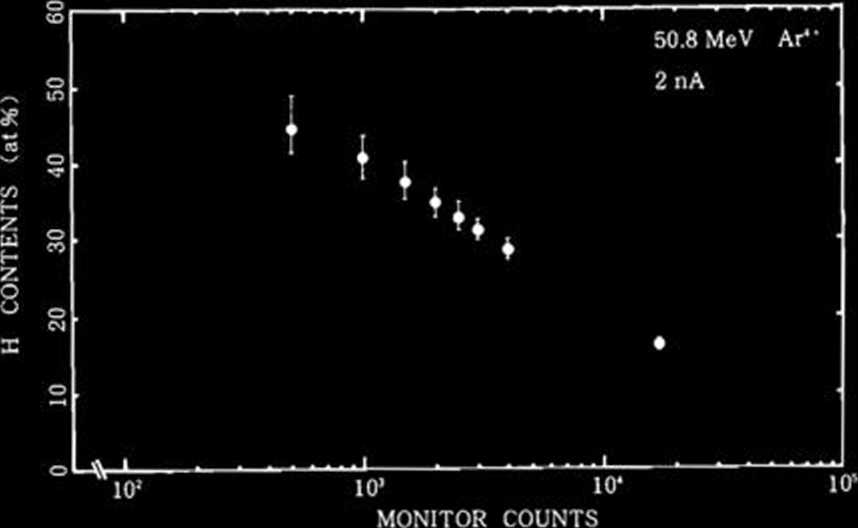372596249
81
RIKEN Accel. Próg. Rep. 24 (1990)
111-3-17. Hydrogen Desorption from Diamond-like Carbon Film during
lon Beam Irradiation
M. Minami, M. Aratani, and M. Yanokura
In measuring hydrogen contents in diamond-like carbon (DLC) films by elastic recoil detection analysis, we observed a decrease in hydrogen contents with the irradiation time.
The DLC films (about 200 nm thick) were pre-pared from methane on Silicon wafers by the elec-tron cyclotron resonance (ECR) Chemical vapor deposition (CVD) method. The size of each film was 20 mm x 10 mm.
The scattering chamber (100 cm in diameter, 2 x 10 '6 Torr) located at the RILAC A-l beam linę was employed. At the center of the chamber, the DLC films were set up at 30° to a 50 MeV incident argon beam of 2 nA. Two surface barrier semicon-ductor detectors (SSD) were arranged at 35° (SSD-1) and at 50° (SSD-2) to the beam. In front of the SSD-1, an aluminium foil (10 m thick) was set up to detect only hydrogen and carbon ions in the specimens.
Figurę 1 shows the decrease in hydrogen con-tent of the DLC film during ion-beam irradiation; no such a decrease was observed for hydrogenated amorphous Silicon (a-Si:H) films.l) The preparation methods for the DLC and a-Si:H films are very similar in Chemical forms of starting materials and decomposition processes. Starting gas was CH4 for the DLC films and SiH4 for the a-Si: H films.
The decrease in hydrogen content may be con-

Fig. 1. Hydrogen desorption from DLC film during ion-beam irradiation.
sidered due to the temperaturę rise in the film resulting from energy deposited by heavy ions. Temperaturę measurements, however, suggested no desorption of hydrogen.2) Thus, it could be con-sidered that hydrogen behaves in the DLC films very differently from that in the a-Si:H films. This interesting phenomenon is should be further inves-tigated.
References
1) M. Aratani and T. Nozaki: Unpublished data.
2) K. Yano, H. Oyama, M. Yanokura, M. Aratani, and M. Minami: This Report, p. 64.
Wyszukiwarka
Podobne podstrony:
56 RIKEN Accel. Próg. Rep. 24 (1990)111-2-22. Electron Spectra from Doubly Excited Boroń lonsProduce
56 RIKEN Accel. Próg. Rep. 24 (1990)111-2-22. Electron Spectra from Doubly Excited Boroń lonsProduce
92 RIKEN Accel. Próg. Rep. 24 (1990)111-5. Instrumentation1. Design of a Microbeamline for a Compact
94 RIKEN Accel. Próg. Rep. 24 (1990)111-5-2. Design of a Decay Muon Channel Using an Axially Symmetr
102 RIKEN Accel Próg. Rep. 24 (1990)111-5-8. Performance of Isotopic Separation in RIPS T.Nakamura,
103 RIKEN Accel. Próg. Rep. 24 (1990)111-5-9. Test Experiment of the GARIS/IGISOL K. Morita, T. Nomu
105 RIKEN Accel. Próg. Rep. 24 (1990)111-5-10. Velocity Distribution of IGISOL lon Beams M. Koizumi,
108 RIKEN Accel. Próg. Rep. 24 (1990)111-5-12. Status Report of the RIKEN Swinger-Magnetic Analyzer
110 RIKEN Accel. Próg. Rep. 24 (1990)111-5-14. Test for Dispersive-Mode Beam Transportto the SMART
116 RIKEN Accel. Próg. Rep. 24 (1990)111-5-19. Responses of Large Position-Sensitive Detectorsto Hea
RIKEN Accel. Próg. Rep. 24 (1990)111-5-25. High Speed Serial Data Link for PC-9801 J. Fujita > PC
11 RIKEN Accel. Próg. Rep. 24 (1990)111-1-2. Three a Disintegration of 12C in the Field of208Pb Nucl
12 RIKEN Accel. Próg. Rep. 24 (1990)111-1-3. Coulomb Breakup Reaction of 90 MeV/u 140 T. Takei, T. M
29 RIKEN Accel. Próg. Rep. 24 (1990)111-1-19. Dissociation Cross Sections of nLiK. Soutome, S. Yamaj
RIKEN Accel. Próg. Rep. 24 (1990)111-1-20. Induced Fission Studied with a Multi-DimensionalLangevin
48 RIKEN Accel. Próg. Rep. 24 (1990)111-2-15. High Resolution L X-Ray Angular Distribution Measureme
63 RIKEN Accel. Próg. Rep. 24 (1990)111-2-28. Development of Nuclear Track Microfilters N. Nakanishi
72 RIKEN Accel. Próg. Rep. 24 (1990)111*3-8. Dry Separation of Radioactive Nuclides from a Gold Targ
więcej podobnych podstron